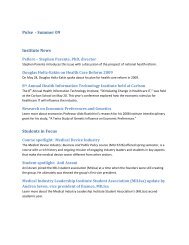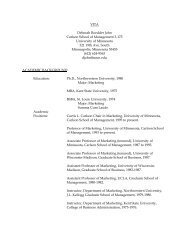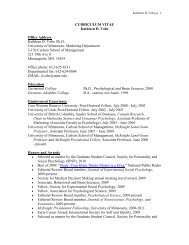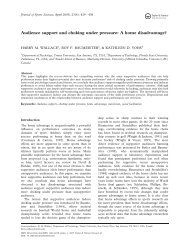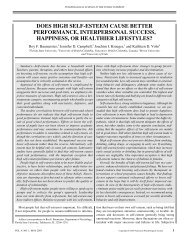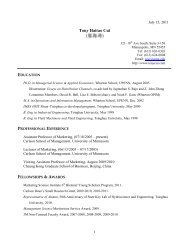Extending Culturally Symbolic Brands - Carlson School of ...
Extending Culturally Symbolic Brands - Carlson School of ...
Extending Culturally Symbolic Brands - Carlson School of ...
Create successful ePaper yourself
Turn your PDF publications into a flip-book with our unique Google optimized e-Paper software.
<strong>Extending</strong> <strong>Culturally</strong> <strong>Symbolic</strong> <strong>Brands</strong>:<br />
A Blessing or a Curse?<br />
CARLOS J. TORELLI<br />
ROHINI AHLUWALIA<br />
Many well-known brands become symbols or icons <strong>of</strong><br />
the cultures or countries with which they are associated.<br />
Examples <strong>of</strong> these brands include Budweiser (American),<br />
Sony (Japanese), Corona (Mexican), Burberry (British),<br />
or Armani (Italian). Branding pr<strong>of</strong>essionals invest<br />
resources in building cultural icons with the expectation <strong>of</strong><br />
being rewarded with stronger market-leadership positions<br />
and higher levels <strong>of</strong> brand equity (Holt 2003; Leibig 2005;<br />
Shaw and Sudhaman 2005). An underresearched question<br />
<strong>of</strong> great interest for both practitioners and researchers is how<br />
a brand’s status as a cultural symbol influences its ability<br />
to leverage its brand equity through product extensions. Our<br />
insights relating to how well-known culturally symbolic<br />
brands differ from other brands, especially in the domain<br />
Carlos J. Torelli (ctorelli@umn.edu) is assistant pr<strong>of</strong>essor <strong>of</strong> marketing,<br />
<strong>Carlson</strong> <strong>School</strong> <strong>of</strong> Management, University <strong>of</strong> Minnesota, 19th Avenue<br />
South, Minneapolis, MN 55455. Rohini Ahluwalia (rahluwalia@umn.edu)<br />
is the Curtis L. <strong>Carlson</strong> Trust Pr<strong>of</strong>essor <strong>of</strong> Marketing, <strong>Carlson</strong> <strong>School</strong> <strong>of</strong><br />
Management, University <strong>of</strong> Minnesota, 19th Avenue South, Minneapolis,<br />
MN 55455. Address correspondence to Carlos J. Torelli. The authors acknowledge<br />
the helpful input <strong>of</strong> the editor, associate editor, and reviewers.<br />
The authors are grateful for grants to the first author from the Institute for<br />
Research in Marketing (University <strong>of</strong> Minnesota), the <strong>Carlson</strong> <strong>School</strong> <strong>of</strong><br />
Management Small Research Grant Program, and the Office <strong>of</strong> the Dean<br />
<strong>of</strong> the Graduate <strong>School</strong> <strong>of</strong> the University <strong>of</strong> Minnesota.<br />
Ann McGill served as editor and Angela Lee served as associate editor<br />
for this article.<br />
Electronically published June 14, 2011<br />
Results from four studies uncover a relatively automatic cultural congruency mechanism<br />
that can influence evaluations <strong>of</strong> culturally charged brand extensions, overriding<br />
the impact <strong>of</strong> perceived fit on extension evaluations. <strong>Culturally</strong> congruent<br />
extensions (i.e., when both the brand and the extension category cue the same<br />
cultural schema) were evaluated more favorably than culturally neutral extensions,<br />
which in turn were evaluated more favorably than culturally incongruent ones (i.e.,<br />
cue two different cultural schemas). The effects emerged with both moderate and<br />
low fit brand extensions, as well as for narrow and broad brands. However, they<br />
only emerged when both the brand and the product were culturally symbolic, likely<br />
to automatically activate a cultural schema but did not emerge for brands low in<br />
cultural symbolism. The effects were driven by the processing (dis)fluency generated<br />
by the simultaneous activation <strong>of</strong> the same (different) cultural schemas by<br />
the product and the brand.<br />
933<br />
<strong>of</strong> brand extensions, are relatively limited (Torelli, Keh, and<br />
Chiu 2010). The scant academic research on this topic suggests<br />
that for well-known brands, country or culture associations<br />
play only a nominal role in attitudes and choices<br />
(Balabanis and Diamantopoulos 2008; Erickson, Johansson,<br />
and Chao 1984; Johansson, Douglas, and Nonaka 1985);<br />
however, marketplace expectancies run counter to it. This<br />
is an important issue, since brand extensions are an important<br />
avenue for growth in today’s highly competitive marketplace,<br />
especially for well-known brands with established<br />
leadership positions and iconic status; however, extension<br />
failure rates are known to be as high as 84% (Tait 2001).<br />
Therefore, insights into factors likely to enhance extension<br />
success are highly consequential.<br />
Interestingly, the majority <strong>of</strong> the prior branding literature<br />
has focused primarily on the role <strong>of</strong> perceived fit in determining<br />
brand extension evaluation and success (Broniarczyk<br />
and Alba 1994; Keller 2002; Loken and John 1993; Park,<br />
Milberg, and Lawson 1991). Importantly, even contextual<br />
factors (e.g., consumer’s mood; Barone, Miniard, and Romeo<br />
2000), brand-specific variables (e.g., breadth <strong>of</strong> the<br />
brand; Meyvis and Janiszewski 2004), and consumer characteristics<br />
(e.g., self-construal; Ahluwalia 2008), have been<br />
known to impact extension evaluation through their influence<br />
on perceptions <strong>of</strong> fit. As such, our knowledge <strong>of</strong> other<br />
drivers <strong>of</strong> brand extension evaluations, such as a brand’s<br />
cultural symbolism, is relatively limited. In contrast to the<br />
deliberate reasoning involved in the perceived fit or country<strong>of</strong>-origin<br />
(COO) assessments that might be relevant for cul-<br />
2011 by JOURNAL OF CONSUMER RESEARCH, Inc. ● Vol. 38 ● February 2012<br />
All rights reserved. 0093-5301/2012/3805-0012$10.00. DOI: 10.1086/661081



